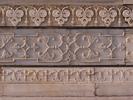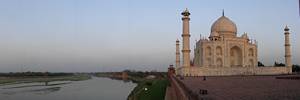In March 2005, I spent three mind-bending weeks in India with my son Alexander
(in silhouette above right)
as my companion and Hindi-speaking cicerone.
My camera did not capture nearly enough of the India which I found most remarkable:
the vendors, the market stalls, the begging children,
the rickshaw-wallahs and paan-wallahs and lime-water-wallahs,
the bikes carrying rebar or auto fenders,
the saddhus, the slums;
my pictures show too many buildings and too few people,
but they'll have to do.
These images represent a very few places in an extremely varied country,
beautiful and hideous, crowded, smelly and filthy,
nerve-jangling and meditative, ancient, vibrant, splendid;
here's a small taste of what we saw.
Click on any image to enlarge, then use the back arrow on your browser to return.
Click here for a slideshow.
Namaste!
My first day in India, immediate immersion: Alexander took me to Chandni Chowk,
an incredibly crowded marketplace in Old Delhi.
This is a nearby street as seen from the Jama Masjid, the largest mosque in India.
The street is filled with people, bikes, pushcarts, cyclerickshaws, scooters,
autorickshaws (the small green and yellow vehicles).
Notice the haphazard electrical wiring, the people on the roof, the foul air quality.
Approaching dusk on the same day, after the overwhelming noise and congestion of Old Delhi,
we stepped into the serenity of the mid-16th century Humayun's Tomb.
In early evening we attended a Sufi concert on the grounds; beautifully lit stage,
great modern sound system, video cameras on elaborate booms, billowing
smoke from the garbage fire right next to us.
Welcome to Delhi!
We spent most of our three days in Benares at the Dhrupad Mela,
a festival of a profound variety of Hindustani classical music.
On the first night, a monkey on the tented roof reached down and grabbed
the gaudy garlands at the back of the stage; that's why the garlands at the far left
don't look quite right here.
We were very sleepy at 4am the next night after 6 hours of music
when a raucous pakhawaj (North Indian classical drum) solo
awakened the local monkey family,
then they screeched and cavorted on the roof for 45 minutes.
Here's one of them chilling on nearby steps at 5am
and a banana-eating mother and child after dawn.
As dawn broke at 6am, we left the Dhrupad Mela for a while as
the locals climbed down the ghats (steps leading to the water)
for a morning dip in the sacred, horribly polluted waters of Gangaji (Mother Ganges).
Then we watched the sunrise over Gangaji from Tulsi Ghat.
From the back of a cyclerickshaw, a wide paved Varanasi street with passing cows.
This is amazingly orderly compared to the old streets closer to the ghats,
where pedestrians, cyclerickshaws, scooters and occasional honking cars share
the narrow dirt street with cows, chickens, stray dogs, goats, and street vendors,
not to mention garbage piles and cow dung.
In Delhi, cows often avoid the terrible traffic by resting on the median strip.
A walk on our first day in Bombay took us through a neighborhood vegetable market
with beautiful produce in great variety.
We thought of Rushdie as we looked down later on Chowpatty Beach and Marine Drive from Malabar Hill.
An hour-long boat ride from Bombay transported us to another world:
the breathtaking Hindu cave temples of Elephanta,
carved into the stone hillside sometime between AD 450 and AD 750.
Fabulous light filters in from the cave entrance, changing as the sun moves through the sky.
Around the corner from the main cave, still on Elephanta,
dozens of playful monkeys cavorted, including this mother and her adorable baby.
Looking north across the water
near the jetty leading to the Mosque of Haji Ali
as the tide ebbed,
two Bombay fishermen and Bombay highrises.
I expected poverty and I expected highrises,
but I didn't expect dire slums with burning garbage
right next to modern highrises.
The Jagish Temple, built by Maharana Jagat Singh in 1651,
with some detail from its ornately carved façade.
Eating breakfast in a rooftop restaurant, we heard even more
commotion than usual from the street below.
The street, barely wide enough for two autorickshaws to pass,
was blocked by a passing Moslem funeral, and
Indians are not shy about honking.
Moments later, an elephant offering rides for tourists
added to the confusion.
Udaipur 3/14/05
Jaipur 3/15/05
We had power outages daily except in Bombay.
During this outage, the man in the red shirt climbed over this transformer's chain-link fence
and up the tower with wrench in hand to disconnect a wire.
The haphazard tangle of wires in the other picture is
more orderly than wiring we saw elsewhere.
Street scenes in the Old City, near Chandpol: pepper vendors with a passing band,
a camel cart, an odd shrine-like vehicle.
The City Palace: restoration work with passing monkeys;
ornate decoration fit for the Maharaja who still lies there.
They look like modern sculpture, but these are
astronomical instruments in the Jantar Mantar, the Royal Observatory
built by Jai Singh ca. 1728.
We later visited his observatory in Delhi too.
Some tourists arrive by elephant at the magnificant hilltop Amber Palace,
begun in 1592, but we just walked up the hill.
Here's Ganesh on an elaborately painted wall.
We headed up the steep, hot, dusty road from Amber Palace
toward the impregnible fort perched on the hillside high above.
Only a few steps from multitudes of tourists, we found ourselves alone
until a long-limbed Hanuman langur bounded by,
then another, eventually two dozen in a convivial social group.
The pictures you've seen all your life do not prepare you for
the reality: the magnificent Taj Mahal, huge beyond all expectation,
flawlessly conceived and executed.
You first see it perfectly framed as you pass through its monumental gateway.
Look at the people on the distant platform for a sense of scale.
And here is the Taj later, its marble turning pink in the serene glow of sunset, with the Yamuna river on the north side.
We spent most of Monday at the Taj too, and it was much less crowded than Sunday.
At sunset the sky went crazy, just for a few minutes.
My last day in India began with a quiet morning at the Qutb Minar,
a minaret started in 1193 and finished in 1368,
adjacent to the remnants of a 12th century mosque with elaborate decorations.










































